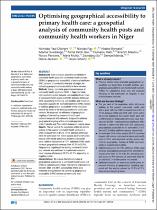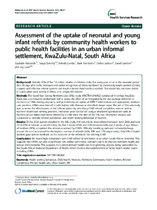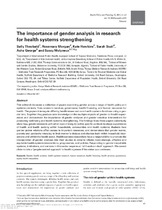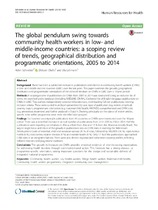Optimising geographical accessibility to primary health care: A geospatial analysis of community health posts and community health workers in Niger
| dc.contributor.author | Oliphant, Nicholas Paul | |
| dc.contributor.author | Ray, Nicolas | |
| dc.contributor.author | Bensaid, Khalede | |
| dc.contributor.author | Ouedraogo, Adama | |
| dc.date.accessioned | 2022-06-20T08:56:33Z | |
| dc.date.available | 2022-06-20T08:56:33Z | |
| dc.date.issued | 2021 | |
| dc.identifier.citation | liphant, N. P. et al. (2021). Optimising geographical accessibility to primary health care: A geospatial analysis of community health posts and community health workers in niger. BMJ Global Health, 6(6) doi:10.1136/bmjgh-2021-005238 | en_US |
| dc.identifier.issn | 20597908 | |
| dc.identifier.uri | 10.1136/bmjgh-2021-005238 | |
| dc.identifier.uri | http://hdl.handle.net/10566/7522 | |
| dc.description.abstract | Background Little is known about the contribution of community health posts and community health workers (CHWs) to geographical accessibility of primary healthcare (PHC) services at community level and strategies for optimising geographical accessibility to these services. Methods Using a complete georeferenced census of community health posts and CHWs in Niger and other high-resolution spatial datasets, we modelled travel times to community health posts and CHWs between 2000 and 2013, accounting for training, commodities and maximum population capacity. We estimated additional CHWs needed to optimise geographical accessibility of the population beyond the reach of the existing community health post network. We assessed the efficiency of geographical targeting of the existing community health post network compared with networks designed to optimise geographical targeting of the estimated population, under-5 deaths and Plasmodium falciparum malaria cases. Results The per cent of the population within 60-minute walking to the nearest community health post with a CHW increased from 0.0% to 17.5% between 2000 and 2013. An estimated 10.4 million people (58.5%) remained beyond a 60-minute catchment of community health posts. Optimal deployment of 7741 additional CHWs could increase geographical coverage from 41.5% to 82.9%. Geographical targeting of the existing community health post network was inefficient but optimised networks could improve efficiency by 32.3%-47.1%, depending on targeting metric. Interpretations We provide the first estimates of geographical accessibility to community health posts and CHWs at national scale in Niger, highlighting improvements between 2000 and 2013, geographies where gaps remained and approaches for optimising geographical accessibility to PHC services at community level. | en_US |
| dc.language.iso | en | en_US |
| dc.publisher | BMJ Publishing Group | en_US |
| dc.subject | Child health | en_US |
| dc.subject | Geographic information systems | en_US |
| dc.subject | Health services research | en_US |
| dc.subject | Health systems | en_US |
| dc.title | Optimising geographical accessibility to primary health care: A geospatial analysis of community health posts and community health workers in Niger | en_US |
| dc.type | Article | en_US |




